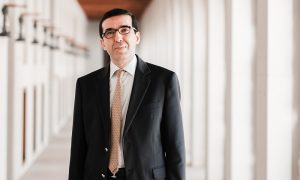Smart Cities Report: Saving resources and energy efficiency in public buildings
Jesús Sancho, Middle East managing director, ACCIONA on promoting more balanced urban planning

Cities have become the most populated places in the world. Their growth changes every year with the increase and arrivals of new inhabitants, and it is estimated that this growth will go on increasing over the next few years. According to the latest UN report, 68% of the population will live in cities in 2050; the building sector has enormous potential to mitigate the impact of climate change in both developed and developing countries.
This scenario means that the main cities have the challenge of becoming smart cities. By making the most of the energy resources and taking advantage of information and communication technology (ICT) data, it is possible to create better infrastructure and city asset management, which promotes more balanced urban planning.
Smart cities create great business opportunities for both the public and the private sectors. One of them involves the optimisation of energy resources through energy efficiency technologies. The aim is to reduce the energy consumption of a given asset and then share the associated savings between the client and the sustainability expert company. In this way, both parties have a tangible – and quite fast – profit, along with a reduction of the carbon footprint for decades to come.
For example, the opportunity to make use of these technologies in the UAE is significant, since buildings there require heavy cooling systems to cope with the extreme seasonal heat and other energy-hungry equipment. The implementation of energy efficiency procedures in those buildings, along with the UAE commitment to renewable energies, is paving the way to drastically decrease the impact to the environment.
It is important to create awareness of energy efficiency practices and to initiate more retrofitting of existing – inefficient – buildings and projects, to reduce overall energy consumption. The residential sector is responsible for the consumption of almost 47% of the GCC’s total energy, against a global average of 25%.
Considering that there are 25,000+ ongoing construction projects in the GCC right now, it is extremely important to join forces, address current challenges and harness the immense opportunities that lie ahead. Systems, hardware and equipment must be updated and appropriately maintained to reach a balance between energy and water savings. Should we not take corrective measures to improve energy efficiency in the building sector, energy demand is expected to rise every year.
One of the key drivers to attain more intelligent buildings and system integration is through the energy savings that can be achieved. Evaluation of occupancy patterns, application of daylight, heating, ventilation and air conditioning (HVAC) and lighting sensors in appropriate locations are only a few examples.
A report published in October 2016 by the International Renewable Energy Agency (IRENA) noted that cities account for 65% of global energy use and 70% of man-made carbon emissions. This makes optimising energy consumption a fundamental objective of a smart city.
Therefore, efficiency is one of the principles that should govern the work undertaken by all public authorities. Achieving the desired effect by using the least possible resources is an obligation that applies to every area of our public administrations. In recent years, this approach has become increasingly relevant to the way they use energy resources. Environmental awareness and the growing public concern about the effects of climate change mean that energy efficiency has become not merely our responsibility but also an opportunity, a way to encourage a greater commitment to sustainability throughout society. By consuming energy sensibly and efficiently, public authorities are taking on an educational role and leading by example.
The most modern technologies for analysing millions of readings
The essential first steps towards saving energy involve understanding how that energy is used, how much energy is consumed, when it is used, and to do what. For this reason, it is essential to do an energy audit on the group of buildings that we want to be more efficient, in order to diagnose energy consumption. Each building is then monitored to produce real-time data on consumption by all the installations and systems: lighting, heating, air conditioning, etc.
By applying these analysis techniques, all sorts of specific savings and efficiency measures are implemented, such as changes to how installations are used, the replacement of obsolete or inefficient equipment, and the use of control and automation devices. This allows a response to isolated alerts raised by unusual consumption and provide information that should lead to operational improvements, the identification of inefficient consumption patterns, etc.
It is imperative to cut down usage of fossil fuel power generation plants in favour of renewable plants and alternative power plants such as waste-to-energy facilities. The newest residential and commercial buildings must meet more stringent energy efficiency targets to accomplish a 30% reduction in energy consumption by 2030. Not being able to do so will leave future generations struggling with all the negative consequences of climate change.
Improving the energy performance of buildings is a key element in the fight against climate change. With the government sector leading the adoption of retrofit projects across the GCC, we are optimistic that the above goals will be accomplished.





